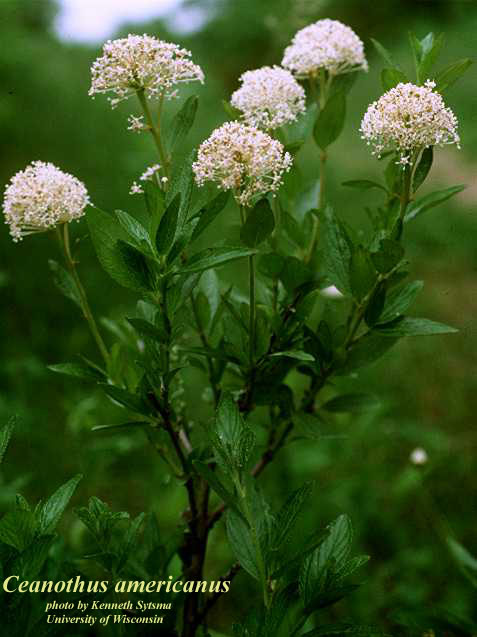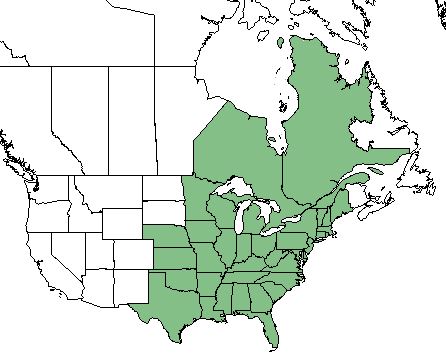Difference between revisions of "Ceanothus americanus"
(→Taxonomic Notes) |
|||
| Line 1: | Line 1: | ||
{{italic title}} | {{italic title}} | ||
| − | Common Names: New Jersey Tea <ref name= "USDA"> [https://plants.usda.gov/core/profile?symbol=CEAM USDA Plant Database]</ref>; Red Root | + | Common Names: New Jersey Tea <ref name= "USDA"> [https://plants.usda.gov/core/profile?symbol=CEAM USDA Plant Database]</ref>; Red Root; Indian Tea <ref name= "1911- gilmore" > [Thirty-Third Annual Report of the Bureau of American Ethnology, to the secretary of the Smithsonian institution, 1911-1912] </ref> |
<!-- Get the taxonomy information from the NRCS Plants database --> | <!-- Get the taxonomy information from the NRCS Plants database --> | ||
{{taxobox | {{taxobox | ||
Revision as of 18:59, 2 April 2019
Common Names: New Jersey Tea [1]; Red Root; Indian Tea [2]
| Ceanothus americanus | |
|---|---|

| |
| Photo by the Atlas of Florida Plants Database | |
| Scientific classification | |
| Kingdom: | Plantae |
| Division: | Magnoliophyta - Flowering plants |
| Class: | Magnoliopsida - Dicots |
| Order: | Rhamnales |
| Family: | Rhamnaceae |
| Genus: | Ceanothus |
| Species: | C. americanus |
| Binomial name | |
| Ceanothus americanus L. | |

| |
| Natural range of Ceanothus americanus from USDA NRCS Plants Database. | |
Contents
Taxonomic Notes
Synonyms: Ceanothus intermedius (Pursh)
Varieties: Ceanothus americanus Linnaeus var. intermedius (Pursh) Torrey & A. Gray; Ceanothus americanus Linnaeus var. americanus
Description
C. americanus is a perennial shrub/subshrub of the Rhamnaceae family native to North America. [1]
Distribution
While it is more commonly found along the coastal plains of the eastern United States and Canada, C. americanus can be found inland as far west as Louisiana. [3]
Ecology
Habitat
The C. americanus is largely found in in sandy soil within woodlands and prairies. [1]
Specimens have been collected from sand in open savanna, dry sand in loam in pine-oak forests, and in open pine land. [4]
Phenology
C. americanus has been observed flowering between April and July, with peak inflorescence in May. [5]
Seed bank and germination
Seedling C. americanus are more likely to thrive when planted in late fall or early winter. [1]
Fire ecology
C. americanus has a high tolerance to drought and fire is a management technique for the spread of the species. [1]
Pollination
Bees may collect pollen from the plant and other insects such as butterflies and moths may just collect nectar. [1]
Use by animals
Many animals such as rabbit, elk and deer eat the grass from C. americanus while others will eat the fruit, turkey and quail for instance. [1]
Diseases and parasites
This species can acquire leaf spot and powdery mildew. [1]
Conservation and Management
Cultivation and restoration
Photo Gallery
References and notes
- ↑ 1.0 1.1 1.2 1.3 1.4 1.5 1.6 1.7 USDA Plant Database
- ↑ [Thirty-Third Annual Report of the Bureau of American Ethnology, to the secretary of the Smithsonian institution, 1911-1912]
- ↑ Weakley, A. S. (2015). Flora of the Southern and Mid-Atlantic States. Chapel Hill, NC, University of North Carolina Herbarium.
- ↑ URL: http://herbarium.bio.fsu.edu. Last accessed: June 2018. Collectors: Andre F. Clewell, Ro.K. Godfrey, R. Komarek, Loran C. Anderson, Bill Boothe, Marcia Boothe, Annie Schmidt. States and counties: Florida (Leon, Liberty, Wakulla, Washington) Georgia (Thomas, Grady)
- ↑ Nelson, G. PanFlora: Plant data for the eastern United States with emphasis on the Southeastern Coastal Plains, Florida, and the Florida Panhandle. www.gilnelson.com/PanFlora/ Accessed: 18 MAY 2018